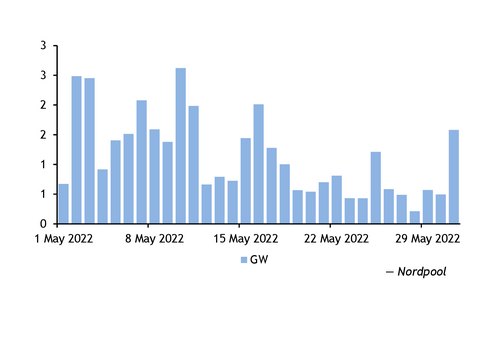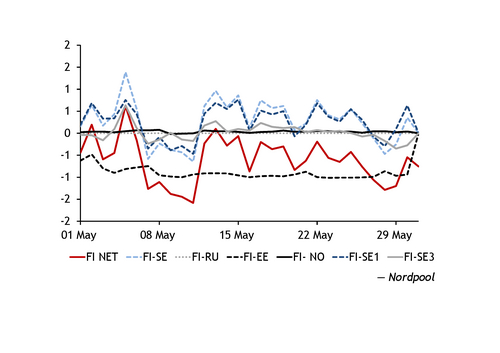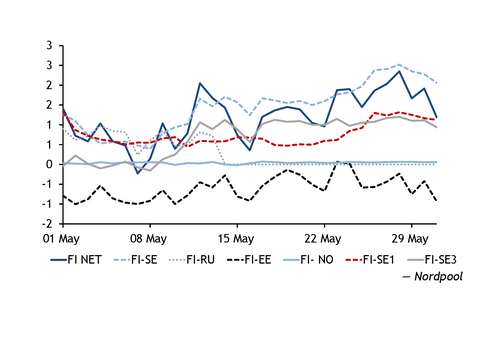Finnish net border power flows averaged 600MW in May, up from net imports of 1.19GW a year earlier, with the country registering a 151pc increase year on year.
Finland reduced net power inflows across nearly all interconnected bidding areas, with net imports from only Sweden's SE1 bidding zone increasing from a year earlier.
Net flows in the Finland-Estonia direction increased to an average of 910MW, from 590MW in May last year, while net imports from Sweden as a whole fell to 270MW from 1.44GW. Finland was a net importer from Russia until 13 May 2022, when it ended border flows because of Russia's invasion of Ukraine.
Finnish power consumption over the first four full weeks of May was down against the same four weeks in the past two years. Finnish demand averaged 7.86GW in weeks 18-21, down from 8.17GW in the same period a year earlier and 8.53GW in 2021 — drops of 4pc and 8pc, respectively.
And Finnish power production has increased year on year over the same periods, by 1.19GW, or 17pc, compared with 2022 to 8.22GW, and from 6.6GW in 2021. Wind output in Finland rose sharply in May from a year earlier, by 42pc, to 1.63GW from 1.15GW, as strong wind conditions and new capacity supported output, while the increased wind generation supported power exports. And strong wind conditions also weighed on the Nordic system-wide day-ahead price during May, which delivered at an average of €38/MWh, down from €114/MWh a year earlier, with the spot delivering at a €22.75/MWh discount to the over-the-counter market price for the May contract.
Norway and Sweden similarly registered lower domestic power demand in May, with Norwegian demand down by 3pc to 12.06GW and Swedish consumption down by 6pc to 12.53GW. But Swedish power generation outpaced the falling domestic demand, with output at 15.57GW, 10pc lower than the 17.72GW in the same four weeks last year.
Finnish nuclear generation was consistent for much of May, averaging 3.46GW from 1-16 May, when the 890MW Olkiluoto 2 (OL2) nuclear power plant was off line for scheduled maintenance. Generation had peaked at 4.3GW at the end of April, once the 1.6GW Olkiluoto 3 began full commercial operations. The OL2 plant resumed operations on 20 May, with Finnish nuclear production ramping up gradually to reach 4.3GW again on 25 May.
Finland's power capacity flexibility has been further assisted by improved hydropower reserves in the region, with Finnish hydro stocks reaching 3.86TWh in week 21, up by 6pc on the week and up from 1.92TWh at the end of April. Finnish hydro run-of-river generation provided a significant proportion of the country's generation mix in May. It provided more than 2GW for several days during the month, peaking at 2.49GW on 12 May.
Finland is likely to remain a net power exporter outside of winter months, during periods of high wind output and full nuclear availability, with 4.3GW of nuclear output representing 54.7pc of the average demand in May, while onshore wind production can exceed 4.3GW, having hit a monthly peak of 4.73GW on 8 May. Finnish summer peak demand is generally 60-70pc of winter peak demand, according to European system operators' association Entso-E. But planned maintenance curtailments at Finnish power plants, with Olkiluoto 3's output reduced until 3 June for additional testing, will probably tighten the country's power supply. And maintenance is expected to be carried out on cross-border interconnectors over the summer period, which may affect cross-border power flows in the coming months.





